

Explicit cookie consent. AT THE beginning of February, somewhere in London, a maternity ward welcomed the city's 8,615,246th inhabitant.

China’s Pearl River Delta overtakes Tokyo as world’s largest megacity. China’s Pearl River Delta has overtaken Tokyo to become the world’s largest urban area in both size and population, according to a report from the World Bank.
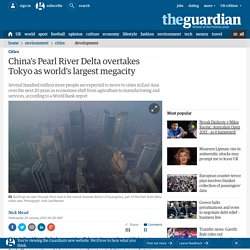
The megacity – which covers a significant part of China’s manufacturing heartland and includes the cities of Shenzhen, Guangzhou, Foshan and Dongguan – is now home to more people than the countries of Canada, Argentina or Australia. Urbanisation which took place over a period of several decades in Europe and North America is happening in just a few years in East Asia, which already contains eight megacities (with populations above 10 million) and 123 cities with between one and 10 million people. With almost two-thirds of the region’s population (64%) still non-urban at present, several hundred million are expected to move to cities over the next 20 years as economies shift from agriculture to manufacturing and services, according to East Asia’s Changing Urban Landscape: Measuring a Decade of Spatial Growth. MoMA: Sci-fi designs for a better future for megacities – in pictures.
The Age of Megacities. Dar es Salaam: Africa's next megacity? 30 July 2012Last updated at 20:34 ET By Joe Boyle BBC News, Dar es Salaam Visionaries hope for a modern metropolis modelled on Singapore, but pessimists fear the emergence of another dirt-poor city of slums.
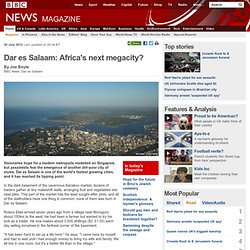
Dar es Salaam is one of the world's fastest growing cities, and it has reached its tipping point. The 12 Global Megacities That Will Boom In The Next 15 Years. Bangkok Becomes First Megacity to Mull Move to Higher Ground. November 25th, 2011 by Susan Kraemer After another year marked by months of epic flooding in the capital city of 12 million, this month AFP reports that lawmakers in Thailand have submitted a parliamentary motion to begin discussions of building a second capital or moving Bangkok to higher ground.

Sataporn Maneerat, a Puea Thai party MP, told AFP Thailand should think about moving the capital or looking to another city for future developments and investments. “Another 19 Puea Thai MPs and I have signed and submitted a motion to parliament to seek approval to set up a committee, to consider whether the capital should be moved or if Thailand should have a second capital,” he said. “Bangkok is sinking every year. Real-life Atlantis? The world's megacities that are sinking 10 times faster than water levels are rising - Science - News.
A new paper from the Deltares Research Institute in the Netherlands published earlier this month identified regions of the globe where the ground level is falling 10 times faster than water levels are rising - with human activity often to blame.

In Jakarta, Indonesia’s largest city, the population has grown from around half a million in the 1930s to just under 10 million today, with heavily populated areas dropping by as much as six and a half feet as groundwater is pumped up from the Earth to drink. The same practice led to Tokyo’s ground level falling by two metres before new restrictions were introduced, and in Venice, this sort of extraction has only compounded the effects of natural subsidence caused by long-term geological processes. "Land subsidence and sea level rise are both happening, and they are both contributing to the same problem - larger and longer floods, and bigger inundation depth of floods," Dr Gilles Erkens, who led the research from Deltares, told the BBC.
Megacity. A megacity is usually defined as a metropolitan area with a total population in excess of ten million people.[1] A megacity can be a single metropolitan area or two or more metropolitan areas that converge.
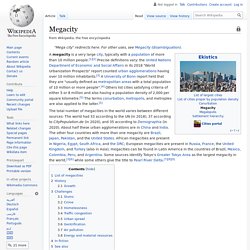
The terms conurbation, metropolis and metroplex are also applied to the latter. As of 2016, there are 35 megacities in existence, Chennai being the latest. The 10 Fastest Growing Megacities In The World. The world’s population is rapidly moving into city centers; by 2050 , seven out of every 10 people on Earth will live in a city. But not every city will be a megacity--defined as an urban area with over 10 million inhabitants--and not every megacity is equally large.
Every year, Demographia releases a comprehensive list of the population, land area, and population density of urban areas with over 500,000 inhabitants. It’s a huge list, as you might imagine. But in looking at the top 10 urban areas by population, some clear patterns emerge. Below, the list. Woes of Megacity Driving Signal Dawn of ‘Peak Car’ Era.
The world that Henry Ford put on wheels is poised for a stall.
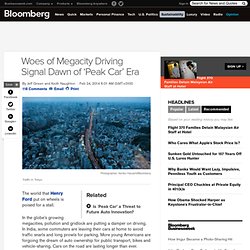
In the globe’s growing megacities, pollution and gridlock are putting a damper on driving. In India, some commuters are leaving their cars at home to avoid traffic snarls and long prowls for parking. Facebook’s big data glimpse at human migration and the growth of mega-cities. Facebook is so ubiquitous—it has 1.19 billion monthly active users, or more than 15% of the Earth’s population—that it’s possible to detect huge migration patterns from a few snippets buried in its users’ profiles, specifically the huge tide of people moving to mega-cities around world. Asia to dominate 21st century megacities. 21 June 2011Last updated at 00:19 Mass urbanisation, the increasing concentration of populations into towns and cities, is one of the defining characteristics of industrialised economies.
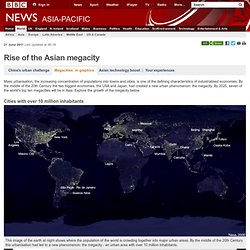
By the middle of the 20th Century the two biggest economies, the USA and Japan, had created a new urban phenomenon: the megacity. By 2025, seven of the world's top ten megacities will be in Asia. Our Fragile Emerging Megacities: A Focus on Resilience. Unless you have been hibernating, you have heard about urbanization trends and have spent time reflecting on what this might hold for the future of communities, cities, nations, and the planet as a whole.
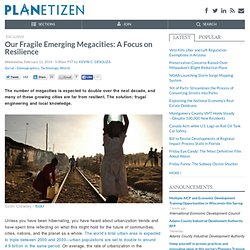
The rise of megacities – interactive. UN report: World's biggest cities merging into 'mega-regions' Youtube - New Cities Summit 2014: Keynote: Future Trends in the Century of Cities. Img - Diplomacity. Img - the scale of Chinese mega regions. Img - World city clusters. World's biggest cities merging into mega-regions. Img - Single cities to mega regions. Mega-Region Development.
The development of mega regions is mostly the outcome of three processes that reinforce the spatial extent and the coherence of an urban system.
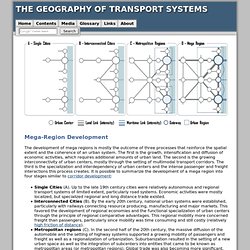
The first is the growth, intensification and diffusion of economic activities, which requires additional amounts of urban land. The second is the growing interconnectivity of urban centers, mostly through the setting of multimodal transport corridors. The third is the specialization and interdependency of urban centers and the intense passenger and freight interactions this process creates. It is possible to summarize the development of a mega region into four stages similar to corridor development: Single Cities (A). UN report: World's biggest cities merging into 'mega-regions'
Our Fragile Emerging Megacities: A Focus on Resilience.
The Pearl River Delta Megacity 珠江三角洲. The Pearl River Delta is slowly growing into a single colossal megapolis (view our PRD map here). Pearl River Delta Megacity. 'One Mega-City, Many Systems': The Evolution of Hong Kong - Parag Khanna and Thomas Sevcik. Ever since the handover of Hong Kong's sovereignty to China in 1997, land reclamation on both the island itself and from Kowloon peninsula have shrunk the breadth of Victoria harbor to a perpetually narrowing strait. This geographical trend turns out to serve as a useful metaphor for the island’s changing politics and economic orientation as China’s control deepens.
Indeed, Hong Kong is quickly becoming the hub of a new version of the "one country, two systems" motto used by the mainland to characterize its relationship with Hong Kong, Macau, and Taiwan. The cluster of cities around (and including) Hong Kong forming the Pearl River Delta – from Shenzhen and Guangzhou in the north to Macao and Zhuhai to the west – are becoming an archipelago of inter-locking hubs with varying policies related to visiting, immigration, business and political freedom. Call it "one mega-city, many systems. " Macau University, courtesy of Macau University Photo credit: leungchopan /Shutterstock. China to create largest mega city in the world with 42 million people. Mega-City Semantics in the Pearl River Delta. Dongguan Housing. Photo by livinginchina4now. Megacity. What is it about London? Population growth is slowing across most of Europe – people are having fewer children and, it could be argued, steps are being taken to try to reduce social inequalities.